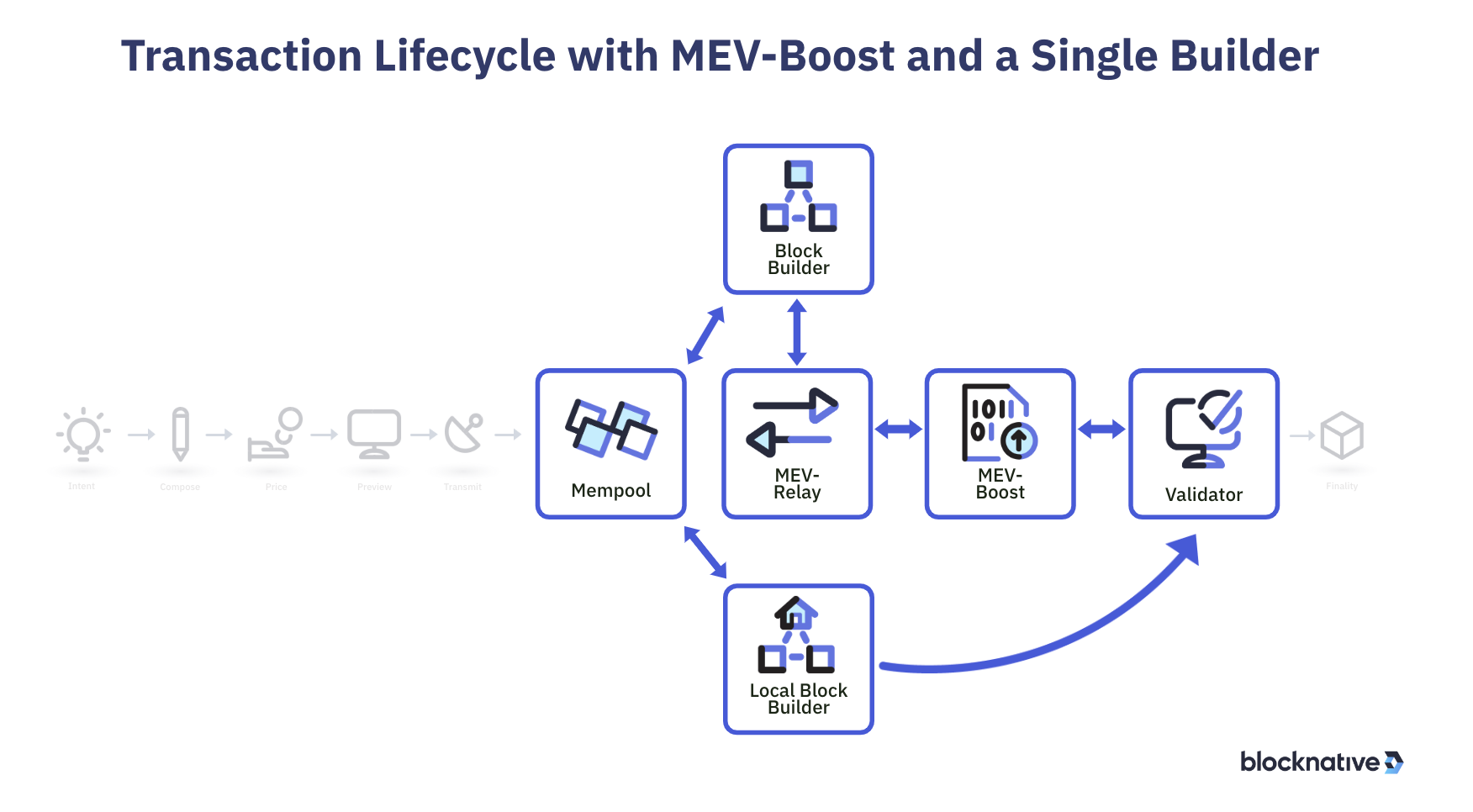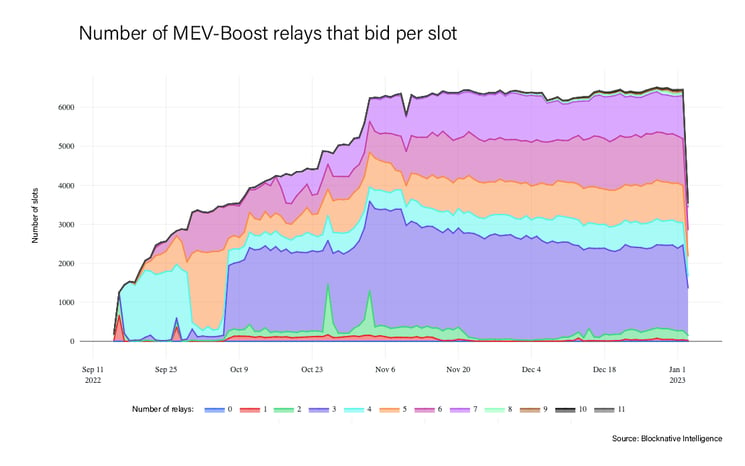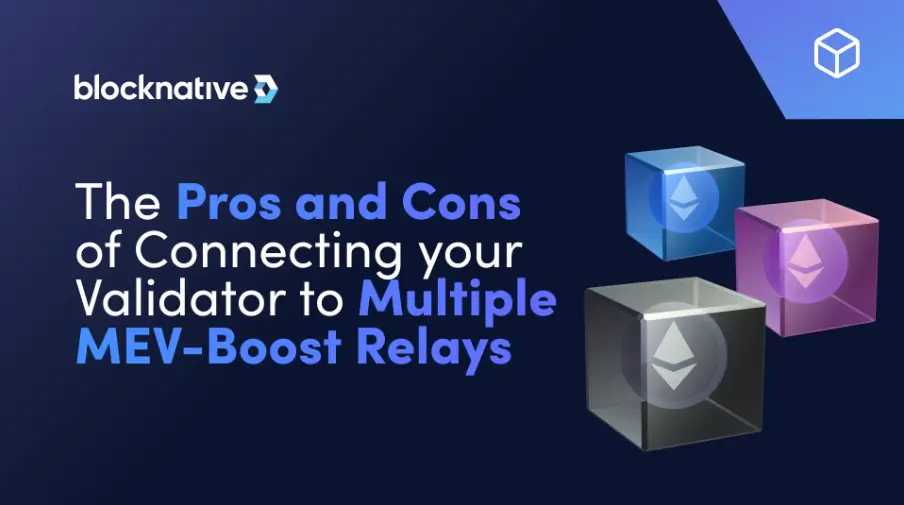MEV-Boost relays bridge the gap between block builders and block proposers (validators). Eventually, these relays will disappear as block builders formally become incorporated into Ethereum's protocol through Proposer/Builder Separation. However, this likely won't happen for a few more years. Until then, relays will continue to play the critical role of sending blocks from highly specialized block builders to validators. With the number of MEV relays continuing to rise, it can be difficult for validators to determine which relays to integrate.
This blog will walk you through the pros and cons of connecting MEV-Boost to multiple relays, the importance of relay diversity, and where to find the necessary metrics to make an informed decision on which relays to connect to.

The Current Relay Landscape
At the time of this article, there are eleven prominent relays operated by nine distinct entities:
- The Blocknative Relay
- The Flashbots Relay
- BloXroute Max Profit, Ethical, and Regulated Relays
- The Eden Relay
- The Manifold Relay
- Ultra Sound Relay
- Agnostic Relay
- Aestus Relay
- Relayooor Relay
Validators can find performance metrics for these relays using dashboards such as relayscan.io or mevboost.org to determine how many blocks each relay has proposed in a given period (a sign of high adoption amongst validators) or the average value of the relay's proposed blocks.
Once set up, validators can add multiple relays to their MEV-Boost instance. The Ethereum ecosystem recommends connecting to multiple relays for a variety of reasons, including maximizing profit, increasing redundancy, increasing the decentralization of the network, and promoting relay diversity.
If you are new to validating and have yet to set up MEV-Boost, check out our blog on getting started with MEV-Boost with the Blocknative Relay.
The Importance of Relay Diversity
Relay diversity refers to two things: the number of relays that validators can connect to and the code base that these relays use.
While there has been significant development in new relays within the past few months, it is not enough for the ecosystem to simply have multiple relays available—these additional relays must be adopted by the validator community and built off of a distinct codebase to ensure software diversity.
Encouragingly, the call for increased relay diversity is mounting in the community, with Coinbase and Lido strongly encouraging the use of multiple relays.
6/ Specifically, relays must perform their core functions reliably–ensuring that block proposal opportunities aren’t missed and that proposers are always paid the promised amount. We are eager to work with any relay operator that can meet these conditions.
— Coinbase Cloud (@CoinbaseCloud) November 1, 2022
However, as it stands, a majority of validators are only connected to 3 unique relays. In December 2022, 36.2% of slots came from validators connected to 3 unique relays; 9.6% came from validators connected to 4 unique relays; 14.6% came from validators connected to 5 unique relays; 18.9% came from validators connected to 6 unique relays; and 16.3% came from validators connected to 7 unique relays. Only 1.7% of validators are connected to 8 or more relays.
As seen in the chart below, the growth of relay diversity amongst validators has remained relatively flat since the last half of November.

To date, only two verifiably unique relay codes exist— Flashbots and Blocknative's Dreamboat. All other mainstream relays are either forked from Flashbot's open-source relay code or are private relays that have yet to share their code. As a result, a bug in Flashbots-based code would impact nearly 450K validators.
We recommend that validators connect to as many trusted MEV relays with diverse codebases as possible to ensure no single team or piece of infrastructure becomes overwhelmingly central to the Ethereum network’s operation.
Advantages of Connecting to a Diverse Set of Relays
There are many benefits that come with connecting to a diverse set of relays. If you are a validator, we encourage you to consider the various relay options available and connect to all relays that meet your given requirements. Doing so is a meaningful contribution to the overall health of the Ethereum network and provides the following personal benefits:
More profit for your validator
Without MEV-Boost your validator proposes blocks from Geth which is not specialized in extracting the maximum profit it can from the transactions available in the mempool. MEV-Boost relays enable validators to potentially earn more profit by connecting their nodes to specialized block builders that compete in real-time to produce the most profitable block. By connecting to a diverse set of relays, a validator can increase the pool of block builders they are connected to, resulting in more blocks to choose from.
To date, MEV-Boost block rewards are 2.66x higher than locally built blocks, while the maximum difference on the daily delta window can reach as high as 7.9x. Different relays are connected to different block builders with different strengths and weaknesses. Different block builders may be connected to a variety of MEV searchers — sophisticated actors that specialize in profit extraction. As a result, some block builders may produce more valuable blocks than others depending on the MEV they contain, the block builder's infrastructure capabilities, or their view of the mempool.
Because MEV-Boost will always choose the block with the highest bid, it is most lucrative to connect to as many trusted relays as possible to increase the diversity of the blocks you receive.
Increase redundancy and resilience
By connecting to multiple trusted relays, you can ensure your validator has additional options if one relay fails. Fortunately, if something goes wrong with MEV-Boost, your validator has the ability to revert back to using Geth to build blocks locally. Doing so means missing out on highly profitable blocks created by block builders and delivered by MEV relays but gives Validators peace of mind that they will still propose a block if something fails.
When connecting to multiple relays you want to keep in mind the diversity of the source code of the relays you are connected to. Having at least two relays with verifiably unique source is important to ensure your rewards continue to flow in case of a bug in a code. There are currently only two verifiably unique open-source relay codes available for relays to build from: Flashbots and Blocknative's public, peer-reviewed, open-source relay Dreamboat.
Open source code encourages third-party review, so it increases security, as well as creative development. As it relates to relays, open-source code allows the community to ensure and verify the relays they use are, in fact, unique. Network resilience requires a diversity of software throughout the stack.
Propose blocks that align with your ethos
Connecting to multiple MEV relays provides a validator with more flexibility and choice in terms of how they earn profit. Different relays offer different perks and you can chose to connect your validator set to a variety of relays. For example, a validator may choose to connect half their validators to relays that maximize profit but filter for OFAC-designated addresses and the other half to relays that don't filter transactions. Other validators may want to chose to only connect to relays that don't contain MEV. The programmability introduced by The Merge and block building means the possibilities could be endless and are largely driven by Validator's wants and needs.
Things to Consider When Connecting to Multiple Relays
Connecting to multiple relays is not without its risks. However, these higher risks come with higher rewards than most validators could produce by building blocks locally. Still, it is important to understand these additional risks. It is important for validators to research new relays to ensure they meet your given needs and risk tolerance before connecting to them. Common concerns when connecting to new relays include:
Increased risk of errors
Connecting to multiple MEV relays can increase your validator's risk of encountering an error. These errors can be minor that have no effect on your validator, or they can be major and cause you to miss a slot. This risk is compounded when all the relays you are connected to share the same or similar source code.
These risks can be mitigated by ensuring you are connecting to relays that have a history of operating low-latency, highly reliable infrastructure for Ethereum. One of the biggest reasons for missed slots amongst validators is latency — either the validator asks for the block too late or the validator takes too long to send it.
Greater complexity
Different relays may have different configurations — for example, some may pay out via a separate transaction in their block that validators can easily see and monitor; others may payout via coinbase transfers that require validators to monitor their net balance changes pre- and post-block proposal in order to see their payment. This can add additional complexity to your validator setup if you aren't prepared for it.
Ethical concerns
It is important to know what kind of blocks a relay is building before connecting to it. Some validators may not want to propose blocks that contain certain types of transactions, such as certain types of MEV. Other validators may not want to propose blocks that contain transactions associated with terrorists or criminal activity. Maybe a validator wants to focus on maximizing profit, or maybe it wants to ensure it is promoting censorship resistance for the network.
Either way, validators have the option to connect to a variety of different relays to fit their needs.
Legal concerns
Depending on the relay or validator's jurisdiction, building or proposing blocks that contain certain types of transactions, such as MEV or OFAC-designated addresses, could come with additional legal risks. It is important to understand the regulatory landscape in your jurisdiction when choosing which relays your validator connects to.
Continuing the Conversation
Relay diversity is critical to the health and security of Ethereum, and comes with many benefits to the validators that are connected to a wide and diverse set of relays. Blocknative believes that the community can work together to solve and encourage the prioritization of relay diversity. This includes supporting new relay operators looking to join the ecosystem, such as Aestus and others that forked the Flashbots relay in recent months.
Following The Merge, Blocknative launched the Blocknative Relay and began our new role as a block builder in Ethereum’s proto-PBS landscape. If you'd like to connect your validators to the Blocknative Relay check out the docs here and join our Discord to chat directly with our team.
If you would like to fork Dreamboat to run an independent relay or have questions about becoming a relay operator, we suggest reaching out via our website’s contact form or our Discord.
Gas Extension
Blocknative's proven & powerful Gas API is available in a browser extension to help you quickly and accurately price transactions on 20+ chains.
Download the Extension


